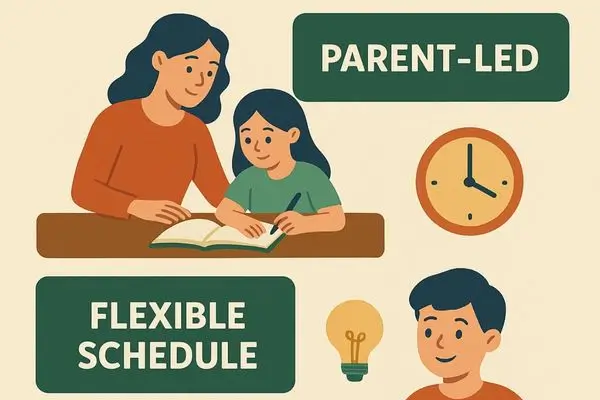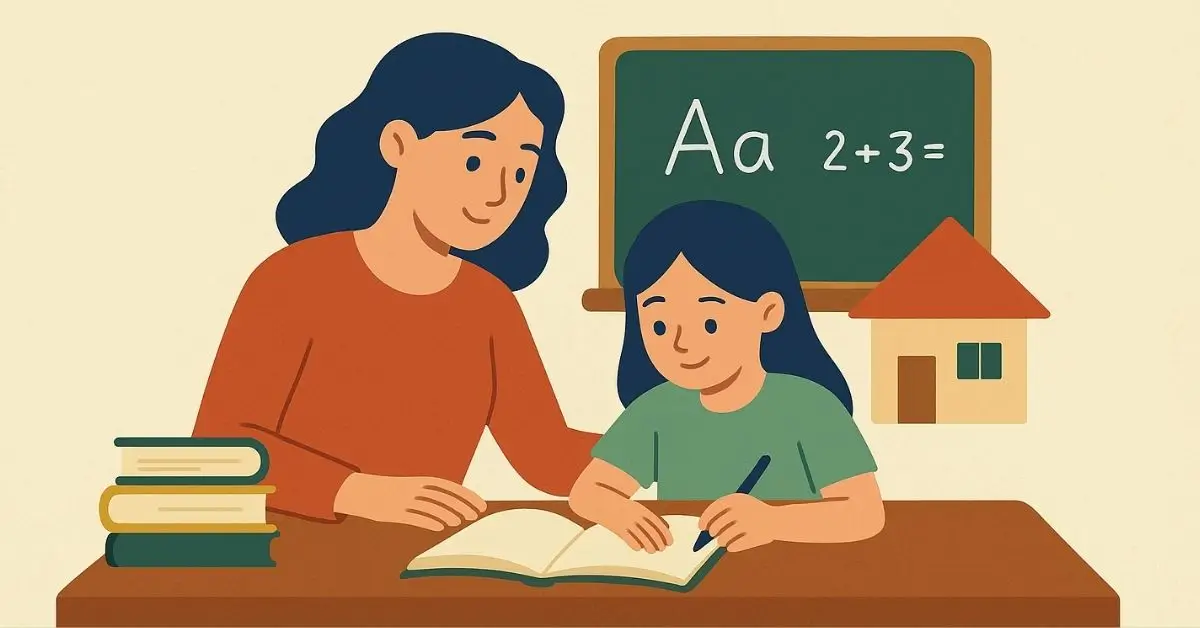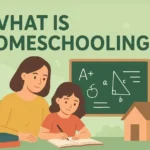Homeschooling is no longer a rare choice. It’s a growing global movement. Parents everywhere are rethinking education and turning their homes into classrooms.
- But what exactly is homeschooling?
- How does it work?
- Is it legal everywhere, and what are its pros and cons?
Main Topics
Table of Contents
This guide by HSTech provides comprehensive answers to all your questions, from the basics of homeschooling to its advantages, disadvantages, and how it differs from traditional schooling.
1. What Is Homeschooling and How Does It Work?
Homeschooling is an educational method where children learn at home under the supervision of their parents or private tutors, rather than attending a traditional school.
It enables families to create a personalized learning plan tailored to the child’s pace, strengths, and interests. Parents can choose textbooks, online classes, or real-world learning experiences to meet academic goals.
How Homeschooling Works Step-by-Step
- Parents select a curriculum or design one.
- They set a learning schedule that fits their lifestyle.
- Students learn at home using books, online tools, and hands-on activities.
- Progress is tracked through tests, assignments, or projects.
- Some students join homeschooling co-ops to study with other children once or twice a week.
Homeschooling can be fully offline, online-based, or a hybrid system that combines both.
2. What Is Traditional Schooling and How Does It Differ from Homeschooling
Traditional schooling takes place in a structured classroom environment, guided by certified teachers. It follows a standardized curriculum, adheres to fixed schedules, and undergoes assessments set by education boards.
Let’s compare both approaches:
| Factor | Homeschooling | Traditional Schooling |
|---|---|---|
| Learning Environment | Home or community-based | Classroom setting |
| Schedule | Flexible | Fixed |
| Teacher | Parent or private tutor | Professional teacher |
| Curriculum | Customizable | Standardized |
| Assessment | Parent-designed or external exams | Set by school/board |
| Social Interaction | Limited but flexible | Set by the school/board |
Both systems have strengths. Homeschooling offers flexibility and personalization, while traditional schooling provides structure and group learning.

3. Homeschooling in the USA: Laws, Requirements, and Trends
In the United States, homeschooling is legal in all 50 states, but each has its own rules. Parents must usually:
- File a notice of intent to homeschool
- Teach specific core subjects (Math, English, Science, etc.)
- Keep attendance or progress records.
- Submit annual evaluations or standardized test results (depending on the state)
Homeschooling Trends in the USA
According to recent research, over 3.1 million students in the U.S. are homeschooled (as of 2025), a number that has tripled in the last decade.
The rise of online learning platforms and digital curricula has made homeschooling more accessible and affordable than ever before.
4. Is Homeschooling Legal?
Homeschooling exists but is not officially regulated by the government. There are no specific homeschooling laws, yet many families choose this method informally.
Parents often use international curricula, such as the Cambridge IGCSE, American online schools, or Montessori-based systems.
Some key points:
- Homeschooling is not illegal, but it is not formally recognized by the state.
- Parents are free to teach their children at home and later register them privately for board exams (O/A levels, matric, etc.).
- Growing communities are now forming homeschooling networks and co-ops to support families.
As awareness grows, countries may introduce clearer homeschooling policies in the future.
5. Advantages of Homeschooling
Homeschooling offers several benefits that traditional schooling often can’t match.
5.1 Personalized Learning
Every child learns differently. Homeschooling allows lessons to match the student’s pace, strengths, and learning style—something standard classrooms struggle to provide.
5.2 Strong Family Bonds
Spending more time together helps parents understand their children better. It also strengthens emotional connections and communication.
5.3 Flexible Schedules
Families can travel, explore, and learn outside strict academic calendars. It’s ideal for working parents or families who move frequently.
5.4 Safe and Supportive Environment
Children study in a comfortable space, free from bullying or peer pressure. Parents can ensure positive mental health and self-confidence.
5.5 Real-Life Learning
Homeschooling often includes practical lessons—like cooking, budgeting, or outdoor science projects—that connect learning to daily life.
6. Disadvantages of Homeschooling
Homeschooling isn’t perfect. It has some real challenges that parents should consider.
6.1 Limited Social Interaction
Without classmates, children might have fewer social opportunities. Parents need to plan playdates or group activities to balance this.
6.2 Time Commitment
Teaching requires daily dedication. Parents must invest time to plan lessons, monitor progress, and keep learning engaging.
6.3 Financial Costs
Homeschooling may require one parent to work fewer hours or stop working altogether. Curriculum, materials, and resources also add up.
6.4 Lack of Access to School Facilities
Labs, sports fields, and extracurricular clubs may not be readily available. Homeschool families often join local centers or online programs to fill this gap.
6.5 Reintegrating into Traditional Schools
If a child returns to public or private school later, adjusting to schedules and exams can take time.
7. Homeschooling Exams and Assessments
Homeschooled students are evaluated in several ways, depending on the country or program. Common methods include:
- Standardized Tests like SAT, ACT, or GED (U.S.)
- Cambridge International Exams (for IGCSE and A-levels)
- Online Curriculum Tests through platforms like Time4Learning or Khan Academy
- Portfolio Reviews, where parents track learning through assignments, projects, and reports
These assessments help ensure academic quality and smooth transitions into higher education.
8. What Is Homeschool and How Does It Work?
Homeschool, or home school, means learning outside the traditional classroom—usually at home. Parents act as teachers and guides.
It works through personalized lessons, flexible routines, and one-on-one attention, often supported by digital platforms and educational communities.
9. What Is the Biggest Disadvantage of Homeschooling?
The biggest drawback most families mention is social isolation.
Children may have fewer chances to interact with peers, join clubs, or develop teamwork skills. However, with homeschool groups, sports clubs, and online communities, this challenge can be managed easily.
10. Is It a Good Idea to Be Homeschooled?
Whether homeschooling is a good idea depends on the child’s personality and the parents’ ability to manage time and resources.
It’s an excellent choice for:
- Students who struggle in traditional schools
- Families who travel often
- Parents who want a values-based or customized education
But it may not suit families needing structured, peer-driven environments. The key is to evaluate your child’s learning needs and family lifestyle first.
11. Homeschool or Home School – Which Is Correct?
Both terms mean the same thing. “Homeschool” is more common in the U.S. and digital content, while “home school” is still used in some regions.
When writing blogs or educational content, “homeschooling” is the preferred SEO-friendly term.
12. The Future of Homeschooling in the Digital Age
Technology is transforming homeschooling. AI-driven learning platforms, virtual classrooms, and digital resources are making education more interactive and practical.
Trends shaping the future:
- Hybrid homeschooling combines online and offline learning
- AI tutors for personalized feedback
- Virtual co-ops where students join global classrooms
- Global recognition of homeschooling diplomas
As education becomes more flexible, homeschooling is likely to play a massive role in the next generation’s learning ecosystem.
See Also: What Is Homeschooling? 5 Main Reasons to Choose the Amazing Education Method
13. Conclusion: Choosing the Right Path
Homeschooling isn’t just about staying at home—it’s about freedom, personalization, and purpose. It gives children the chance to learn in a way that fits them best, while giving parents more control over their education.
However, it also requires discipline, time, and planning. If you’re considering homeschooling, start by researching local laws and connecting with homeschooling networks for support.
Education isn’t one-size-fits-all—and homeschooling proves that beautifully.


